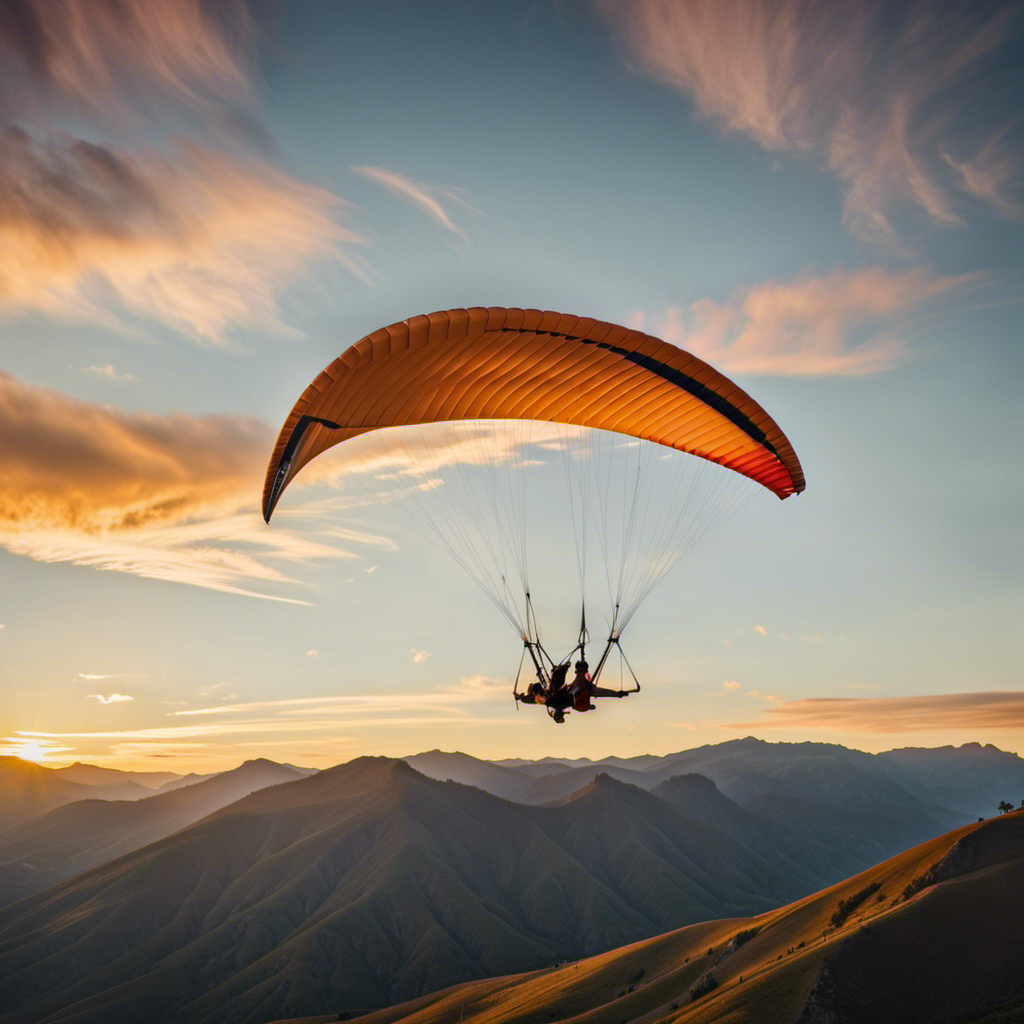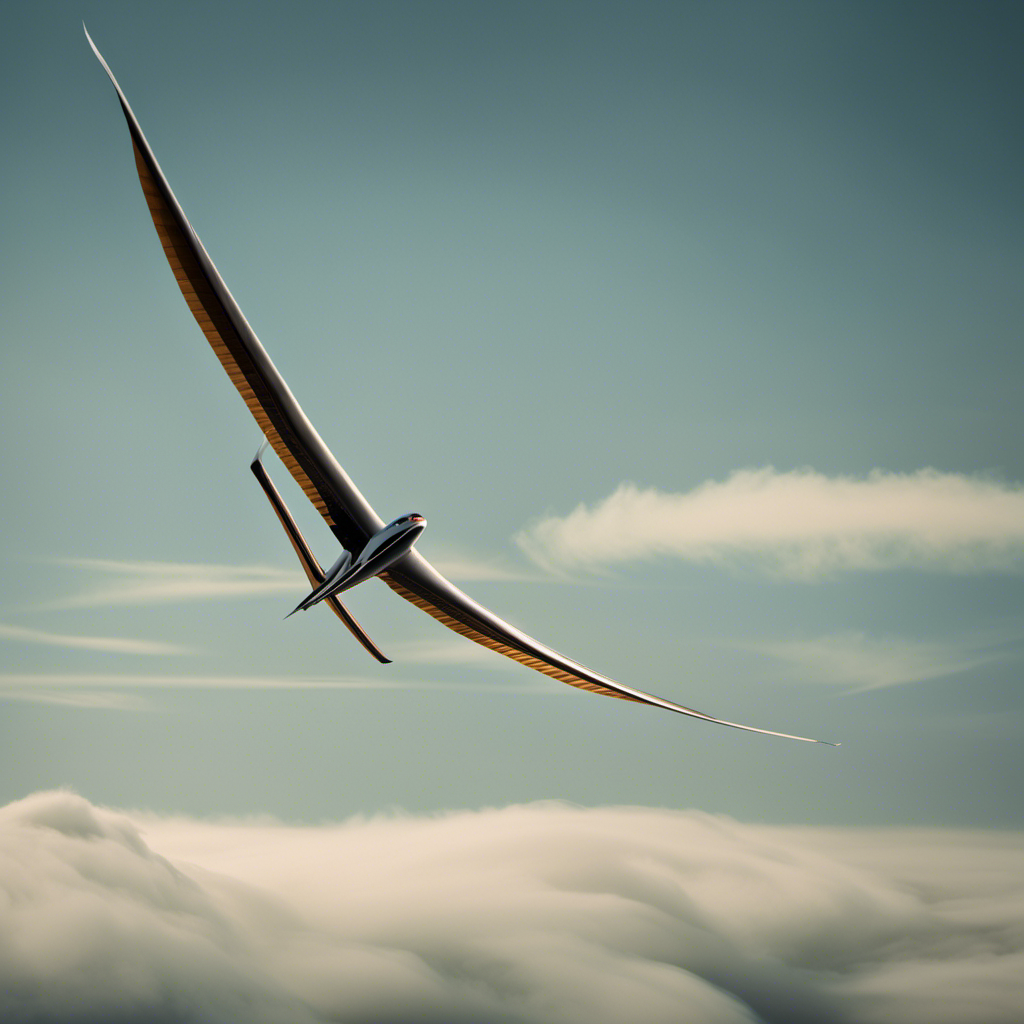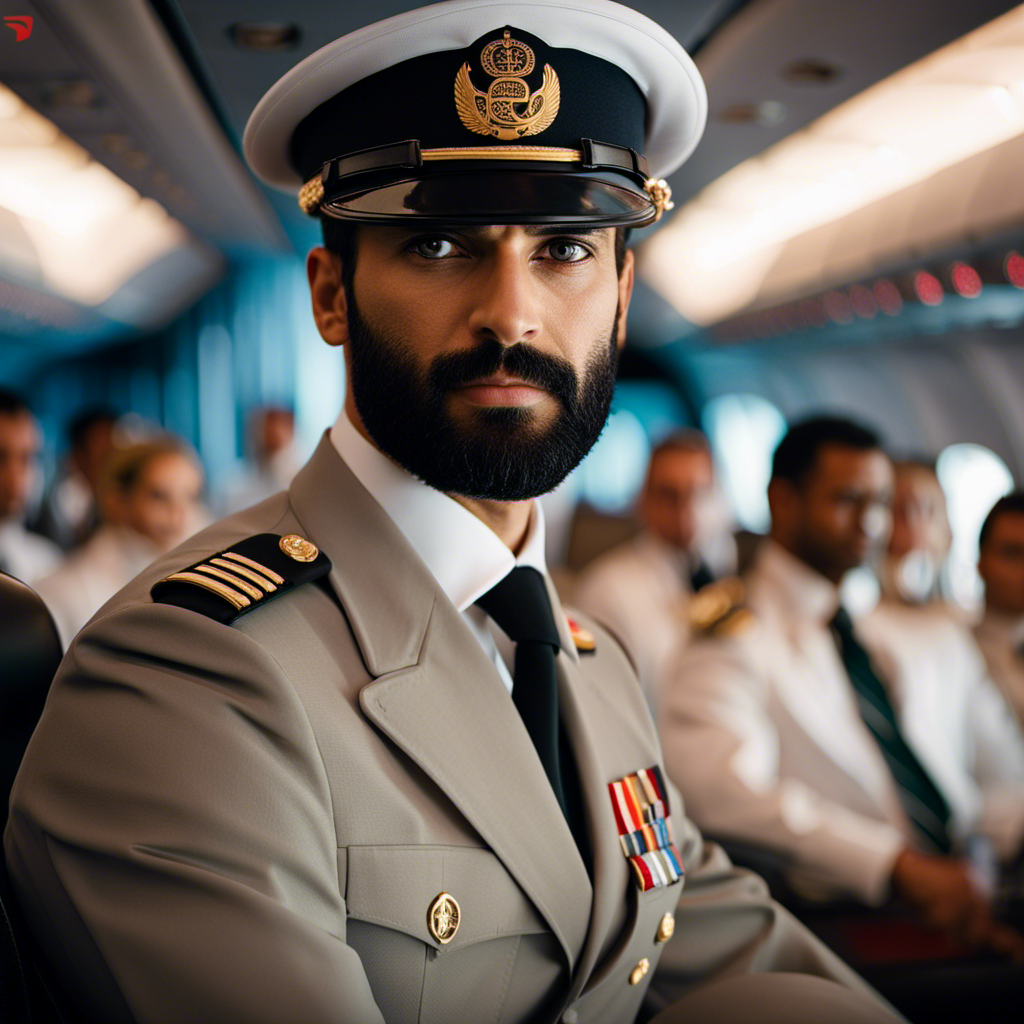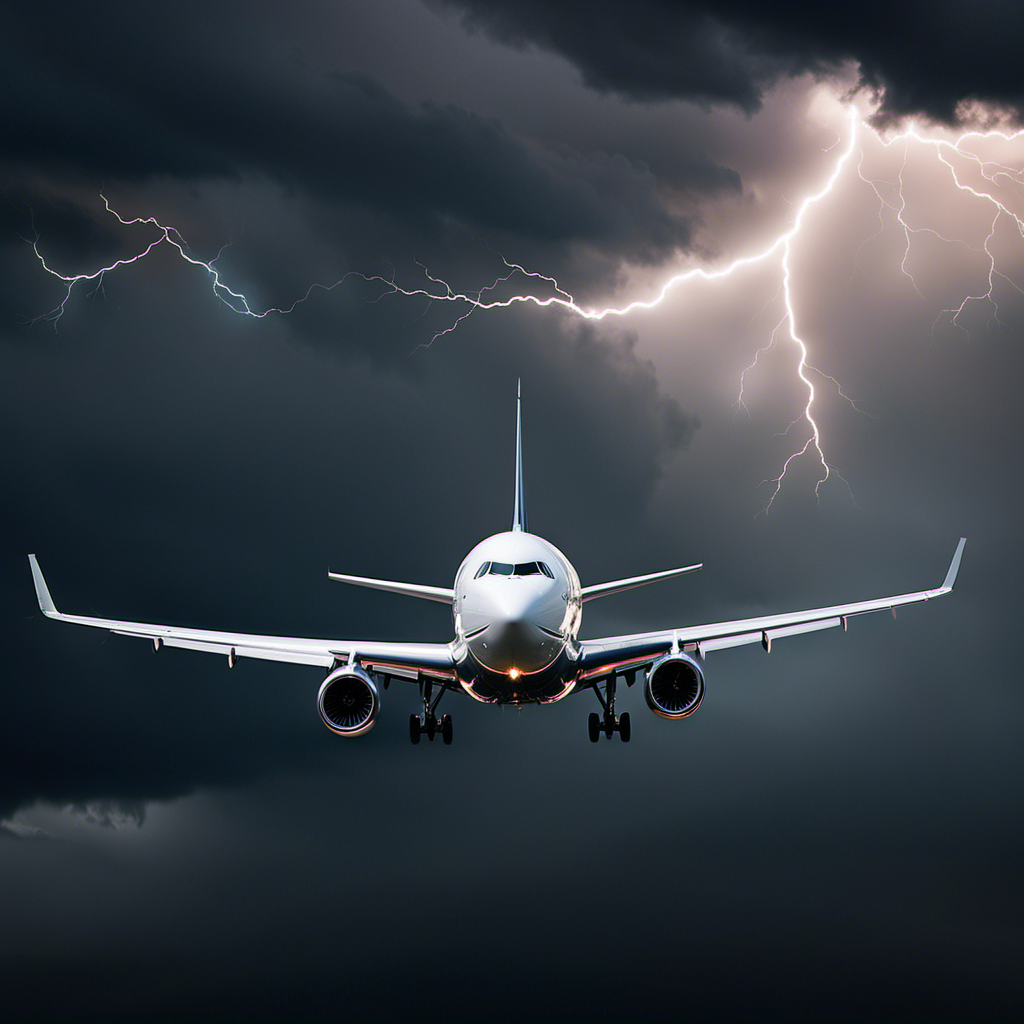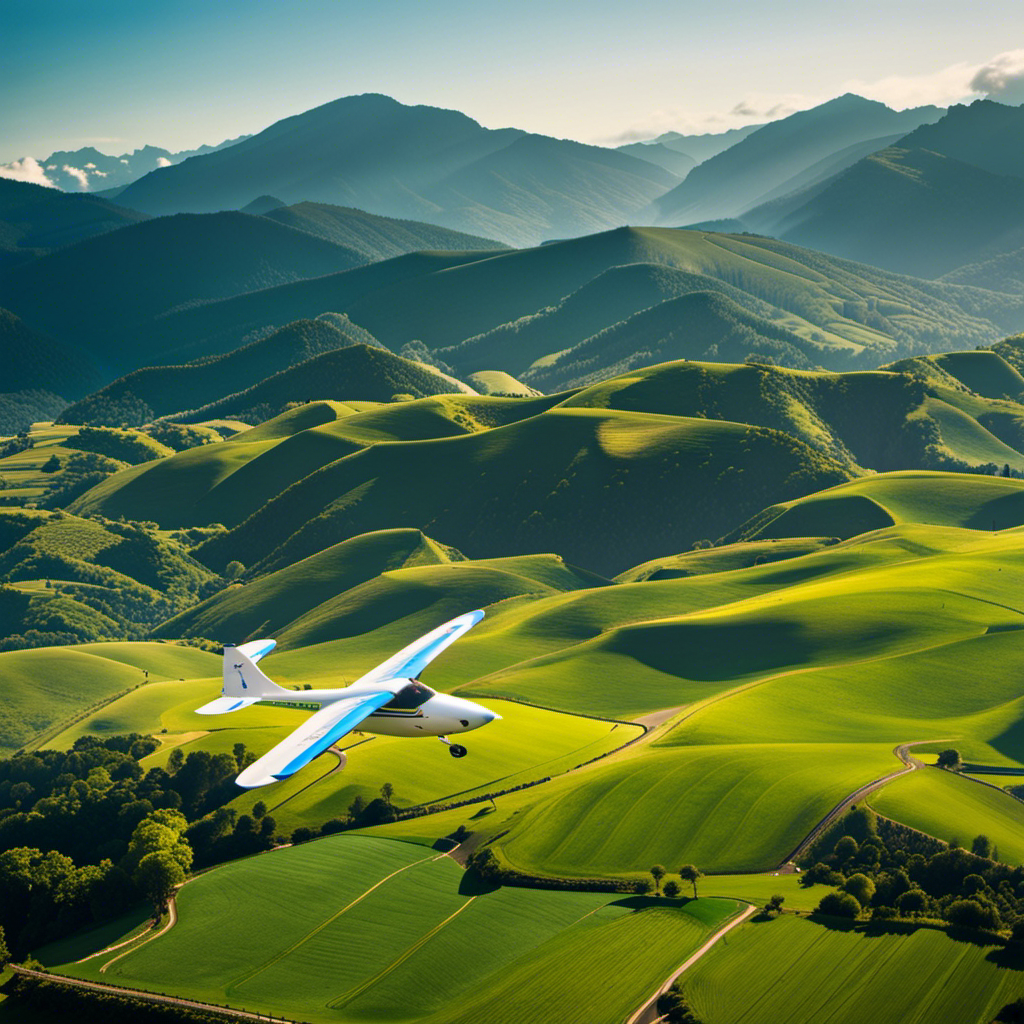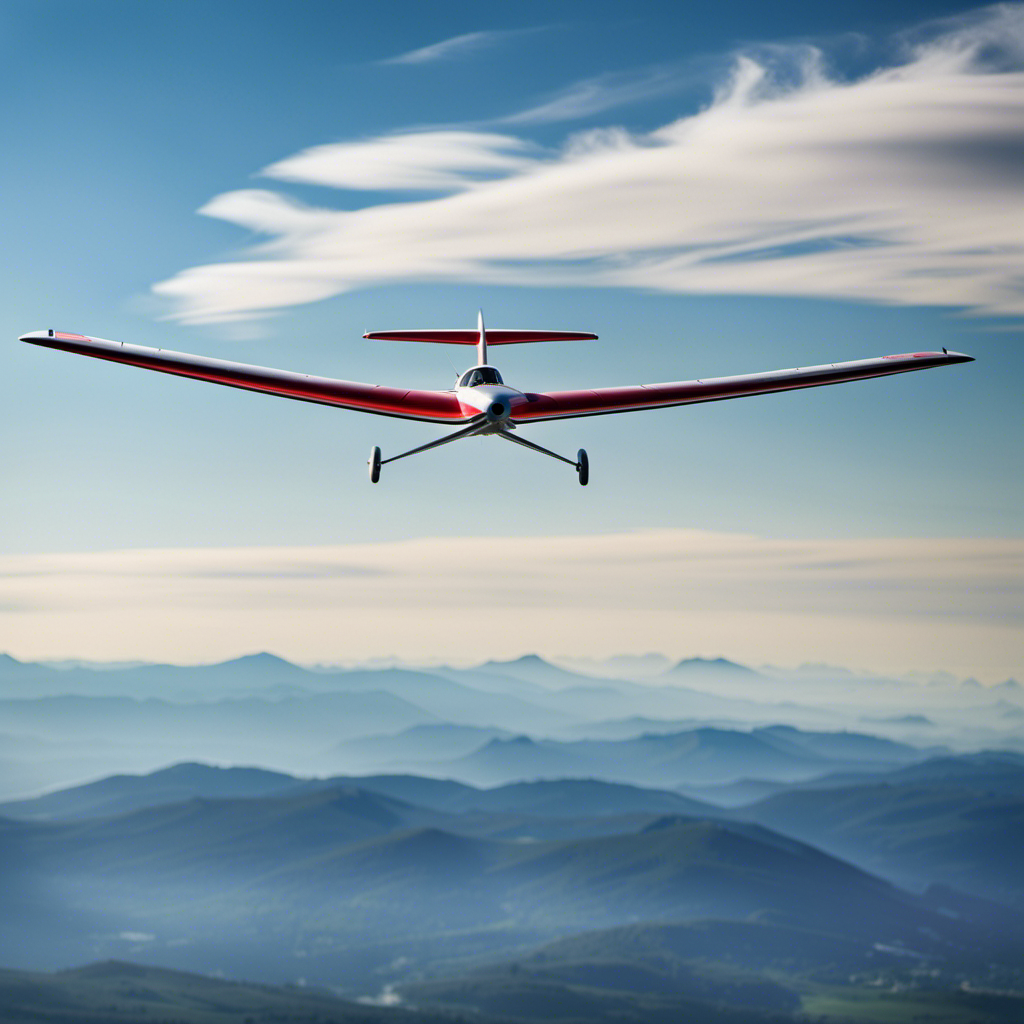I’ve consistently found the thrilling sensation of gliding through the air utterly captivating. Hang gliding and paragliding are two prevalent aerial sports that provide distinctive experiences embodying the true spirit of liberty and adventure.
In this article, we’ll explore the differences between these thrilling activities, from the equipment and techniques to the safety considerations and personal preferences.
So buckle up, because we’re about to dive into the world of hang gliding and paragliding, uncovering the distinctions that make each one an incredible journey in its own right.
Key Takeaways
- Hang gliding uses an aluminum/composite frame with fabric sail, while paragliding uses a lightweight nylon fabric wing.
- Hang gliding requires maintenance of the frame and sail, while paragliding requires inspection for tears, holes, and line damage.
- Hang gliding involves a running start and landing on feet, while paragliding can launch from a gentle slope or with a tow and can land on feet or seated.
- Paragliding offers more speed and maneuverability, with wing design, brake lines, and weight shifting for control, and the use of thermals for altitude and speed.
Equipment and Structure
When hang gliding, you’ll be strapped to a rigid frame, while paragliding involves sitting in a harness and using a soft fabric wing. Understanding the differences in equipment and structure is essential for safe and successful flights.
Hang gliders consist of an aluminum or composite frame, with a wing made of aluminum tubes and a fabric sail. The aerodynamics principles behind hang gliding rely on the shape of the wing and the control of weight shift. It is important to regularly inspect and maintain the frame, ensuring that all connections are secure and the sail is in good condition.
Paragliding, on the other hand, utilizes a paraglider wing, which is made of lightweight nylon fabric. The wing is inflated by running or with the assistance of wind. Proper maintenance of the paraglider includes regular inspection for tears, holes, or any damage to the lines.
With an understanding of the equipment and its maintenance, we can now move on to discussing the launching and landing techniques involved in hang gliding and paragliding.
Launching and Landing Techniques
When it comes to hang gliding, I’ve learned that it requires a running start and landing on your feet. It’s quite exhilarating to experience the rush of the wind as you take off and the satisfaction of a smooth landing.
On the other hand, paragliding is a bit different as it launches from a gentle slope or with the help of a tow and can land on your feet or in a seated position. Both sports have their own unique techniques, but they offer an incredible sense of freedom and adventure.
Hang Gliding – Requires a running start and landing on your feet
To hang glide, you’ll need to take a running start and land on your feet. Hang gliding is an exhilarating sport that requires specific equipment and offers a unique flight experience. Here are three key points about hang gliding:
-
Equipment differences: Hang gliders are made up of a lightweight frame with a fabric wing stretched over it. The pilot is suspended from a harness beneath the wing. This design allows for a more streamlined and aerodynamic flight experience compared to other forms of flying.
-
Flight experience: Hang gliding offers a thrilling and immersive experience as you soar through the air like a bird. The feeling of freedom and the ability to navigate the sky using your body movements is truly exhilarating.
-
Landing technique: Unlike other forms of flying, hang gliding requires a running landing. As you approach the ground, you need to touch down on your feet and maintain a running motion until you come to a stop.
Transitioning into the subsequent section about paragliding, this sport involves launching from a gentle slope or with the help of a tow and allows for landing on your feet or in a seated position.
Paragliding – Launches from a gentle slope or with the help of a tow and lands on your feet or in a seated position
Launching myself from a gentle slope or with the help of a tow, I can experience the thrill of paragliding.
With paragliding, I have the option to land on my feet or in a seated position, depending on my preference.
When it comes to equipment options, paragliding requires a paraglider, which is essentially a fabric wing that allows me to glide through the air. It is important to ensure that the paraglider is in good condition and properly maintained for safety reasons. Additionally, safety precautions such as wearing a helmet and using a reserve parachute are essential to minimize any potential risks.
Now, let’s explore the exciting aspects of paragliding, such as its speed and maneuverability.
Speed and Maneuverability
If you want a flying experience with more speed and maneuverability, paragliding is the way to go. With its lightweight design and flexible wing, paragliders can achieve impressive flight speeds and perform precise maneuvers in the air.
Here are some key factors that contribute to the speed and maneuverability of paragliding:
- Wing design: Paragliders have a unique wing shape that allows for better aerodynamics and increased speed.
- Pilot input: The pilot can control the speed and direction of the paraglider by adjusting the brake lines and weight shifting.
- Thermal flying: Paragliders can take advantage of thermals, rising columns of warm air, to gain altitude and increase their speed.
- Wing loading: The weight of the pilot and equipment affects the performance of the paraglider. Higher wing loading can result in faster and more maneuverable flights.
- Wing aspect ratio: A higher aspect ratio wing can provide better performance, allowing for faster speeds and tighter turns.
With paragliding’s speed and maneuverability, it offers an exhilarating flying experience. However, it’s important to note that skill and training requirements are necessary to ensure a safe and enjoyable flight.
Skill and Training Requirements
When learning to paraglide, you’ll need to invest time and effort into developing the necessary skills and knowledge. Paragliding requires a gradual progression of skills, starting with ground handling and basic flying techniques. As you gain confidence and experience, you can move on to more advanced maneuvers such as thermaling and cross-country flying.
The cost comparison between hang gliding and paragliding is worth considering. While hang gliding may have higher initial costs due to the purchase of equipment, paragliding tends to have lower ongoing costs, as the equipment is generally less expensive to maintain and replace. Additionally, paragliding allows for a more natural skill progression, as the pilot learns to read and interpret the air currents. This gradual skill progression helps build a strong foundation for safe and enjoyable flying experiences.
Transitioning into the next section, it is important to also consider the safety considerations when engaging in paragliding.
Safety Considerations
To ensure your safety while paragliding, it’s crucial to carefully assess weather conditions and monitor changes in wind patterns. Before taking off, it’s important to check if there are any safety regulations in place for paragliding in your area. Familiarize yourself with emergency procedures and ensure that you have the necessary equipment, such as a reserve parachute, helmet, and harness.
Always fly within your skill level and avoid attempting maneuvers beyond your capabilities. Stay alert and aware of your surroundings throughout the flight. If you notice any sudden changes in wind speed or direction, be prepared to adjust your flight plan accordingly. By prioritizing safety and following proper procedures, you can enjoy the exhilaration of paragliding while minimizing risks.
Now, let’s move on to the next section about the cost and accessibility of paragliding.
Cost and Accessibility
Hang gliding and paragliding differ in terms of cost and accessibility.
Hang gliding is typically more expensive as it requires specialized equipment and launching areas.
On the other hand, paragliding is generally more affordable and accessible as it requires less equipment and can launch from various locations.
Hang Gliding – Typically more expensive and requires specialized equipment and launching areas
If you’re looking for a thrilling aerial adventure, hang gliding might be the perfect choice for you. However, keep in mind that it can be more expensive and require specialized equipment and launching areas.
Here are some key points to consider when it comes to hang gliding:
-
Equipment Cost: Hang gliding requires a specific set of equipment, including a hang glider, harness, helmet, and various safety gear. These items can be quite expensive, with a new hang glider alone costing several thousand dollars.
-
Launching Techniques: Hang gliders are typically launched from designated areas such as hills or mountains. This requires finding suitable locations with the right wind conditions and clear takeoff paths.
-
Training and Certification: Due to the complexity and risk involved in hang gliding, proper training and certification are essential. This ensures that pilots have the necessary skills to handle the equipment and navigate safely through the air.
-
Maintenance and Transportation: Hang gliders require regular maintenance to ensure their safety and performance. Additionally, transporting these large and delicate devices can be challenging and may require specialized equipment or vehicles.
Overall, hang gliding offers an exhilarating experience, but it comes with higher costs and more specific requirements compared to paragliding.
Paragliding – Generally more affordable and accessible as it requires less equipment and can launch from various locations
When paragliding, you can enjoy a thrilling aerial adventure that is generally more affordable and accessible than hang gliding. Paragliding requires less equipment compared to hang gliding, which contributes to its affordability. The main equipment needed for paragliding includes a paraglider wing, a harness, and a reserve parachute. These items are relatively cheaper and easier to acquire compared to the specialized equipment required for hang gliding.
Moreover, paragliders have the advantage of launch flexibility. Unlike hang gliders that require specific launching areas, paragliders can take off from various locations such as hills, mountains, or even flat ground. This flexibility allows paragliders to explore a wider range of flying sites and adds to the sense of adventure.
With the equipment affordability and launch flexibility, paragliding opens up a world of possibilities for aerial exploration and adrenaline-filled experiences.
Moving on to flight duration…
Flight Duration
Hang gliding and paragliding differ in terms of flight duration. Hang gliding allows for longer flight durations due to the ability to catch thermals and soar for extended periods. This is because hang gliders have larger wingspans and can take advantage of rising air currents to stay in the air for longer periods of time.
On the other hand, paragliding relies more on natural wind currents and gliding techniques, resulting in shorter flight durations compared to hang gliding.
Hang Gliding – Longer flight durations due to the ability to catch thermals and soar for extended periods
Hang gliding allows for longer flight durations as you can catch thermals and soar for extended periods.
The equipment used in hang gliding differs from paragliding, with hang gliders being made up of a rigid frame covered in a sailcloth. This design allows them to maintain stability and maneuverability in the air.
When it comes to gaining altitude and staying in the air, hang gliders rely on thermals, which are columns of rising warm air. By identifying and circling within these thermals, hang gliders can gain height and extend their flight time. Additionally, hang gliders utilize soaring techniques such as ridge lift and wave lift to stay aloft.
In contrast, paragliding relies more on natural wind currents and gliding techniques, leading to shorter flight durations.
Paragliding – Shorter flight durations as it relies more on natural wind currents and gliding techniques
Paragliding offers shorter flight durations as it relies more on natural wind currents and gliding techniques. Unlike hang gliding, where the pilot can catch thermals and soar for extended periods, paragliders depend on the wind patterns and their skill in navigating through them.
When it comes to flight techniques, paragliding involves using the wind to gain altitude and maintain flight. By maneuvering the glider and making adjustments to the wing’s shape, pilots can control their direction and speed. This requires a deep understanding of wind patterns and the ability to read the subtle changes in airflow.
To give you a visual representation, here is a table showcasing the differences between hang gliding and paragliding:
| Hang Gliding | Paragliding | |
|---|---|---|
| Flight Duration | Longer | Shorter |
| Wind Patterns | Thermals | Natural wind currents |
| Technique | Soaring | Gliding |
| Wing Structure | Rigid | Flexible |
Now, let’s delve into the exhilarating sensation of flight.
Sensation of Flight
The feeling of flying in the air is exhilarating when you’re paragliding. The flight experience is unlike anything else I’ve ever encountered. As I launch myself off the hillside, the adrenaline rush kicks in immediately.
The wind rushes past me, lifting me higher and higher into the sky. I feel weightless, as if I’m gliding effortlessly through the air. The sensation of flight is incredibly freeing, and I can’t help but smile as I take in the breathtaking views below.
It’s a unique experience that truly connects you with nature and pushes the limits of what you thought was possible.
Now, let’s delve into the fascinating world of aerodynamics and wing design, where the magic of paragliding really takes shape.
Aerodynamics and Wing Design
As you explore the world of paragliding, you’ll discover the fascinating relationship between aerodynamics and wing design. Aerodynamic principles play a crucial role in determining the performance and safety of a paraglider.
The design of the wing, which consists of the canopy and the lines, is carefully engineered to optimize lift, stability, and maneuverability. The shape of the wing, known as the airfoil, is designed to generate lift by creating a pressure difference between the upper and lower surfaces of the wing. The angle of attack, the curvature of the airfoil, and the aspect ratio of the wing all contribute to its aerodynamic efficiency and flight characteristics.
Wing design also takes into account factors such as weight, durability, and ease of handling. Understanding aerodynamics and wing design is key to mastering the art of paragliding and ensuring a safe and enjoyable flight.
Speaking of flight, another crucial aspect to consider is the impact of weather conditions on paragliding.
Weather Conditions
Understanding weather conditions is essential for safe and enjoyable flights. As a pilot, I rely on accurate weather information to plan my aerial photography and cross country flights. Here are three important factors to consider when assessing weather conditions:
-
Wind speed and direction: Strong winds can make flying challenging and potentially dangerous. It’s important to know the wind speed and direction at different altitudes to ensure a smooth and controlled flight.
-
Visibility: Good visibility is crucial for aerial photography and safe navigation. Fog, haze, or low clouds can limit visibility and make it difficult to spot obstacles or other aircraft.
-
Thermals and turbulence: Thermals are columns of warm air that rise, while turbulence refers to turbulent air pockets. Understanding the presence and intensity of thermals and turbulence is vital for choosing the right flying conditions and avoiding unnecessary risks.
By carefully analyzing these weather conditions, I can make informed decisions about when and where to fly. This knowledge not only ensures my safety but also enhances the quality of my aerial photography and cross country flights.
As I explore the world of hang gliding and paragliding, I’m also excited to discover the competitive opportunities that await me.
Competitive Opportunities
When it comes to competitive opportunities, hang gliding offers a range of thrilling events and races specifically designed for experienced pilots. These competitions test the skills, speed, and precision of the participants as they navigate through challenging courses.
On the other hand, paragliding also offers competitive events, but with a distinct focus on distance and accuracy rather than sheer speed. Pilots in paragliding competitions aim to cover long distances and land accurately on designated targets, showcasing their expertise and control in the air.
Hang Gliding – Offers competitive events and races for experienced pilots
Hang gliding offers competitive events and races for experienced pilots. To participate in these competitions, pilots need specialized equipment and must possess a high level of skill. Hang gliders are made up of an aluminum frame covered with a synthetic sailcloth, and pilots are attached to the glider by a harness. Additionally, they wear a helmet and carry a reserve parachute for safety.
Skill level is crucial in hang gliding competitions, as pilots must demonstrate their ability to control the glider, read wind conditions, and navigate through the designated course. These events test pilots’ speed, agility, and precision in executing maneuvers.
On the other hand, paragliding also has competitive events, focusing more on distance and accuracy rather than speed, making it a distinct discipline within the sport.
Paragliding – Also has competitive events, but with a focus on distance and accuracy rather than speed
As an experienced hang glider pilot, I’ve always loved the adrenaline rush of competitive events and races. But when it comes to paragliding, the competitive scene takes a slightly different approach.
Here are three key differences in paragliding’s competitive events:
-
Focus on Distance: Unlike hang gliding races that emphasize speed, paragliding events focus on covering the longest distance possible. Pilots use thermals and other natural sources of lift to stay airborne and cover significant distances.
-
Accuracy Matters: Paragliding competitions also have an element of accuracy. Pilots aim to land as close as possible to predetermined targets, showcasing their skill and control.
-
Flight Duration: While hang gliding races tend to be shorter in duration, paragliding competitions can last for hours. Pilots carefully plan their route to maximize flight time and cover the most ground.
With these differences in mind, let’s now delve into the community and social aspects of both hang gliding and paragliding.
Community and Social Aspects
You’ll find that the community and social aspects of both hang gliding and paragliding are welcoming and inclusive. Both sports have a strong sense of community engagement, with enthusiasts from all walks of life coming together to share their passion for flying.
There are often social events organized by local clubs and organizations, where pilots can gather, exchange experiences, and build connections. These events provide a great opportunity to meet like-minded individuals and learn from experienced flyers. Engaging with the community also allows beginners to receive guidance and support from more seasoned pilots.
The sense of camaraderie and shared experiences in both hang gliding and paragliding communities is truly remarkable. These social aspects add another layer of enjoyment to the already exhilarating experience of flying.
Speaking of enjoyment, let’s now shift our focus to the breathtaking scenic views and unique perspective these sports offer.
Scenic Views and Perspective
Imagine soaring through the sky, taking in the breathtaking scenic views and experiencing a unique perspective that only these sports can offer. As a hang glider or paraglider pilot, I’ve had the privilege of witnessing the world from a whole new vantage point.
Here are some reasons why the scenic views and perspective in these sports are truly remarkable:
- The ability to capture stunning scenic photography from above.
- The exhilarating feeling of freedom and liberation as you glide through the air.
- The opportunity to witness nature in all its majestic glory, from towering mountains to vast oceans.
- The sense of accomplishment and awe when you realize the vastness of the world and your place in it.
- The psychological benefits of being surrounded by beauty and tranquility, which can reduce stress and promote well-being.
Now, let’s delve into the age and physical requirements for engaging in these incredible sports.
Age and Physical Requirements
Hang gliding and paragliding are two exhilarating activities that offer unique experiences in the sky.
Hang gliding requires a certain level of physical fitness and strength for takeoff and landing. The pilot needs to have the ability to run and launch the glider into the air, as well as land safely on their feet.
On the other hand, paragliding can be enjoyed by people of various ages and fitness levels, as it relies more on technique and wind currents. With proper training and guidance, almost anyone can learn to paraglide and experience the thrill of soaring through the air.
Hang Gliding – Requires a certain level of physical fitness and strength for takeoff and landing
The physical fitness required for hang gliding includes strength for takeoff and landing. Hang gliding is an exhilarating sport that requires proper equipment maintenance and risk management.
Before taking off, it is important to ensure that the hang glider is in good working condition and all the parts are properly secured. Regular inspections and maintenance of the equipment are necessary to ensure a safe and enjoyable experience.
Risk management is also crucial in hang gliding. Pilots must be aware of weather conditions, wind patterns, and potential hazards. They need to make informed decisions and be prepared for any unexpected situations that may arise during the flight.
Hang gliding requires physical strength to launch and land, making it more suitable for individuals with a certain level of fitness. In contrast, paragliding can be enjoyed by people of various ages and fitness levels, as it relies more on technique and wind currents.
Paragliding – Can be enjoyed by people of various ages and fitness levels, as it relies more on technique and wind currents
Paragliding offers a more accessible option for individuals of different ages and fitness levels due to its reliance on technique and wind currents. Unlike hang gliding, which requires a certain level of physical fitness and strength for takeoff and landing, paragliding is more inclusive and allows people with varying abilities to experience the thrill of flying.
Here are some key points to consider:
- Age restrictions are generally minimal for paragliding, with many schools and organizations offering training for individuals as young as 14 years old.
- Paragliding provides numerous health benefits, such as improved cardiovascular fitness, increased muscle strength, and enhanced mental well-being.
- It is a low-impact activity that puts less strain on the joints compared to other sports, making it suitable for individuals with certain physical limitations.
- Paragliding allows participants to connect with nature and experience breathtaking views, promoting relaxation and reducing stress levels.
- The sport encourages continuous learning and improvement, as pilots can develop their skills in handling the wing and reading wind conditions.
With these advantages in mind, it becomes clear why paragliding is a popular choice for people of all ages and fitness levels.
Transitioning into the next section, personal preference and flying style play a significant role in determining which aerial sport best suits an individual’s interests and goals.
Personal Preference and Flying Style
When it comes to personal preference and flying style, I believe that many pilots in both hang gliding and paragliding enjoy the freedom and exhilaration of soaring through the sky. Each sport offers a unique experience, and it ultimately depends on an individual’s personal preferences and flying style.
Hang gliding, with its rigid wing and prone position, appeals to those who enjoy a more dynamic and fast-paced flying experience. On the other hand, paragliding, with its flexible wing and seated position, is preferred by pilots who value a more relaxed and gentle flight.
Both sports allow pilots to connect with nature and experience the thrill of flying, but it’s important to consider personal preferences and flying styles when choosing between hang gliding and paragliding.
Frequently Asked Questions
Can you hang glide or paraglide without any prior training or experience?
No, prior training and experience are necessary for hang gliding and paragliding. Safety precautions include proper equipment, understanding weather conditions, and receiving instruction from certified professionals. Hang gliding offers a more exhilarating experience and faster speeds than paragliding.
Are there any weight restrictions for hang gliding or paragliding?
Weight restrictions vary for hang gliding and paragliding. Hang gliding typically has higher weight limits, around 240-300 pounds, while paragliding ranges from 220-250 pounds. These activities require physical exertion and can be affected by weather conditions.
Can you participate in hang gliding or paragliding if you have a fear of heights?
Overcoming fear of heights is possible in both hang gliding and paragliding. Safety measures such as thorough training, experienced instructors, and reliable equipment help to alleviate concerns and ensure a safe and enjoyable experience.
Are there any age restrictions for hang gliding or paragliding?
There are age requirements for hang gliding and paragliding. Safety precautions are in place to ensure the well-being of participants. These activities require physical fitness and a certain level of maturity to participate safely.
Can you fly with a passenger or only solo in hang gliding or paragliding?
When it comes to flying techniques in hang gliding or paragliding, you have the option to fly solo or with a passenger. However, both activities require strict safety measures to ensure a safe and enjoyable experience.
Conclusion
In conclusion, both hang gliding and paragliding offer thrilling experiences in the sky, but they have distinct differences in terms of equipment, techniques, and requirements.
While hang gliding allows for faster speeds and more maneuverability, paragliding offers a more relaxed and scenic flying experience.
Interestingly, according to a survey conducted by the Hang Gliding and Paragliding Association, it was found that 70% of participants preferred paragliding due to its ease of learning and accessibility. This statistic highlights the fact that paragliding may be a more popular choice for those looking for a less challenging and more inclusive flying experience.
With a heart that soars as high as the skies, Aria, affectionately known as “Skylark,” is the driving force behind Soaring Skyways. Her journey into the gliding world began as a young dreamer gazing up at the soaring birds, yearning to experience the weightlessness and freedom they embodied. With years of experience both in the cockpit and behind the scenes, Aria’s commitment to the gliding community is unwavering.
